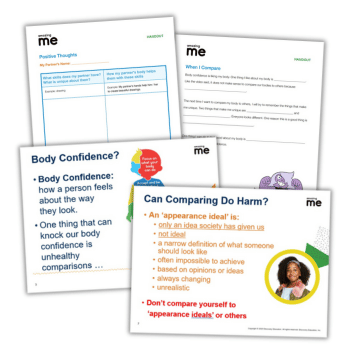5 ways to help students overcome stress, fears and anxieties

As exam season approaches, help your pupil breaking down barriers to learning and overcome their fears

In education, we are in the business of helping students to be the best that they can be.
Every day we strive to improve and develop understanding of quadratic equations, of forming the passé composé of irregular verbs with precision and accuracy, to forming meaningful relationships and being tolerant of differences and diverse lifestyles.
That said, we do our best to make sure students have the knowledge they require to decipher exam papers and ‘do well’.
But before we get to that stage are we providing our young people with the necessary skills to regulate their own thinking so they can stop, think and deal with the challenges they face at school, in life and at home?
Students need to know when to stop and self-regulate, we all do. Over coming weeks and months there will be mock exams, more mock exams and then the real and very final terminal assessments where even more than ever before will be tested in exam halls across the land. Are students truly ready for these new style more challenging terminal exams?
Although we may have created differentiated tiered assessments to work through, generated practice homeworks and crafted knowledge organisers fine tuning knowledge using key vocabulary and structures, completed walking-talking mocks so students are aware of what to write and when but do we teach them how to stop worrying, so they can be their best so they can really show what they know?
Students don’t want to fail, they don’t want to look daft in front of their peer group nor do they want to mess up these new style summer assessments.
Many students I teach worry, they are concerned about the many homeworks, test papers and revision exercises they have to complete nightly to meet each teachers demands. They are doing the best they can but some of them don’t stop working pushing themselves through to the early hours of the morning or working through the night to avoid punishment, embarrassment or failure.
Refusing natural urges to sleep, rest and recharge, ceasing engagement in enriching sporting activities, instrumental lessons or creative endeavours and no longer heading out to parties with their peer group (celebrating milestone birthdays) nor battling it out with other teens for a weekend job because they are worrying, excessively.
This is the reality for so many of the students in secondary classrooms in our schools. The mental health crisis amongst young people is well documented in the national media and is a national scandal.
Schools are doing their utmost to develop well rounded students but following are a few ideas to help your students overcome their fears and stop worries in their tracks. I’m fairly certain that teachers and school leaders may find these useful too.
1. Overcoming Worry
Everyone worries. It is normal to worry, telling students that its ok to worry and, that everyone does it might allow feelings of relief all around, however that doesn’t help it to stop, nor control it so any relief will be short-lived. Controlling worry is the key to keeping anxiety at bay.
Helping students to confront their worries through a simple activity will help them to acknowledge, control worry and master it.
By allowing time to think about their specific worry but ask themselves ‘is it a current worry that I can do something about?’ (Allow thinking time please). There is a simple Yes-or-No response. If the answer is ‘no’ then the worry is hypothetical, in this case we should direct them to a distraction technique to encourage them to stop worrying about something they are unable to do anything about.
Distraction techniques could be a physical activity (sport, running, bouncing a ball against a wall, walking the dog or playing football with a sibling) a mental activity (a puzzle, crossword, Sudoku, playing a card game, counting backwards, playing a musical instrument or singing a song, painting or drawing, a craft activity) or simply a focus activity seeking out specific details whilst looking out of a window – what can be seen? Count 10 blue items, 10 red, 10 green etc.
These allow the focus to shift from worry on to other things, allowing the mind to rest, the worry to dissipate and will prevent overthinking and negativity.
If the answer is ‘Yes’ this is a practical worry, so a different technique is required, one that will solve or help to solve the problem. Most people tend to like solving problems if given time to think about the array of potential solutions.
Example – I have so much work to do plus everyone is moaning at me for not being tidy.
The solution requires time and careful thought. There are a series of steps to complete before arriving at the best solution for the cause for worry:
- Step 1 – Identify the problem
- Step 2 – Identify the possible solutions
- Step 3 – List the pros and cons for each solution
- Step 4 – Create an action plan
- Step 5 – Implement the action plan
- Step 6 – Review the plan and make amendments / changes
| Potential solutions | Pros | Cons | Best solution |
|---|---|---|---|
| Create a timetable allocating time to organise time | List of tasks and work to do is clearly timetabled | • This is wasting time initially and it will have to be continually updated • I might not stick to it |
Short-term solution with longevity |
| Set a timer to complete each task | • The time is clearly divided in to manageable chunks • Increased focus on the task • Not continually checking a watch/phone/clock |
What if I don’t finish all of the task before the timer ends? | Short-term solution with longevity |
| Ask a friend to study/revise with me | • A set time and place and task will be completed together – two minds are better than one • Could be done on Skype/Facetime rather than in the same room • This might not take place straight away |
Run out of data! | Short-term solution with longevity |
| Do my best tonight in the time I have leaving some out | It gets some of the tasks completed quickly | The quality is not good and may result in further work/a consequence | No |
| Leave it and copy up from a classmate at another time | • Stop worrying about it now • Time to do other things |
The task never gets done | No |
2. Thinking – changing the negative in to a positive
Perspective is everything and if in a negative mindset then instinctively we never perform at our best.
Steering students in to a more positive and healthier way of thinking will always be a challenge but if we provide students with tools to help them help themselves we might avoid the downward spiral of negative thoughts thus keeping perspective.
Ask students to consider the following questions:
- Is the thought (being worried about) fact or opinion?
- Is there an alternative interpretation of the situation?
- What would a friend say faced with this situation?
- Would I see this differently if I wasn’t feeling stressed / tired / under pressure?
- Am I over-estimating the worry?
- Am I underestimating my ability to cope / deal with this?
The realisation that thoughts are opinions rather than actual fact can be mind-blowing for some but it might help the vicious downward spiral of negativity, worry and anxiety to be halted.
Challenging thoughts in this way enables calm and perspective to take charge, improving responses to difficult / worrying situations.
3. Procrastination
Putting off something we have to do despite the potential negative consequence; this is procrastination. Social media, YouTube and games on smart phones and tablets are popular havens for procrastinators.
Ask students to think about the following completing the activity:
| What do you procrastinate about? | What is the impact of your procrastination? | Why do you procrastinate? |
|---|---|---|
| • When do you choose to not do something you know you need to do? • Do you procrastinate about work / school / relationships / chores / finances / your future / looking after your health? |
Maybe not washing up / tidying your room / putting your clothes away / sorting your school bag / completing the homework or revision task isn’t too serious but playing on your tablet / smartphone rather than completing the task might have negative consequences | • Do you tell yourself you’ll do it later or that are too tired? • Is there something else you think you have to do first? (eg walk the dog, feed the cat, clean out the hamster) |
| List here: |
Identify 1 area you need to work on. Detail it here: |
Be honest – detail it here: |
Allow students to think carefully might help them to overcome procrastination. Repeating this activity at the start or end of a lesson or registration / tutorial session might help remind them to not procrastinate.
Experience informs me that they will find their own solutions to overcoming procrastination such as:
- Write a list of tasks to be completed
- Prioritise the list (by date/by consequence!)
- Consider potential obstacles/challenges they may face and have to overcome
- Set SMART goals
- Allocate a maximum time limit to complete each task
4. MAGIC Activities
MAGIC activities allow the focus to be broken from worry and tasks for a period of time which can only be refreshing and revitalising yet few have heard of this or indeed practice it.
Beautifully simple, MAGIC activities allow worry to be put aside in the completion of these activities; they are brilliant distractors.
Students could be directed to complete five MAGIC activities per week, or one per day. This will help find balance and time to breathe before continuing with the prioritised tasks previously identified.
M for Mindful Pay attention to your surroundings, your feelings, your emotions and sensations when you do an activity.
A for Active Move more; go for a walk, do some physical activity or spend some time on a neglected hobby.
G for Generous Show kindness and generosity to someone else by doing something nice for a friend, family member, carer, neighbour. Perhaps help out a friend or family member – it could be as simple as a phone call to help someone smile, by doing the washing up or walking the dog. It could be as simple as a smiling and acknowledging the presence of someone else and holding the door open for them as they pass by.
I for Interested Be interested in the world around you, challenge yourself to learn something new through watching a YouTube video or reading up about something you heard, read more or develop new knowledge or skills.
C for Connected Stay connected to family and friends, talk to people and develop relationships.
5. Finding Balance
The rollercoaster of life is exhilarating, is full of twists and turns as well as ups and downs and finding balance is crucial to success. We can’t work ourselves to the point of exhaustion yet achieve the highest echelons of success if that is our goal.
It is our job to ensure that students find balance too through building resilience or ‘bounceback-ability’.
Failure isn’t a dirty word and getting things wrong isn’t a crime, we have to embrace this and not ridicule it nor shy away from it but we do have to help students to learn from it.
Edison’s quote of ‘I have not failed. I’ve just found 10,000 ways that won’t work’ fits beautifully here as does Winston Churchill’s ‘Success is not final, failure is not fatal; it is the courage to continue that counts’.
As a race, humans build resilience through developing positive relationships with others – despite this being a significant challenge for some, we should ensure healthy, supportive and respectful relationships feature in our students lives but as professionals we must model these at all times providing support, opportunities for development and understanding through professional conduct.
Ultimately finding balance is a lifelong quest but if we consider the elements outlined above I’m certain we can all help our students, and ourselves to achieve a better balance.
Further Reading and support organisations:
- blurtitout.org
- youngminds.org.uk
- mind.org.uk
- gov.uk
- bbc.co.uk
- getselfhelp.co.uk
- huffingtonpost.com
- mhfaengland.org
Crista Hazell is a subject leader for MFL, has been teaching for 19 years and is a national council member of the Association for Language Learning (ALL) and an associate for Independent Thinking. She blogs about the adventures in her classroom at cristahazell.wordpress.com and is on Twitter @CristaHazell. She also contributed to There Is Another Way: The Second Book of Independent Thinking by Ian Gilbert.











